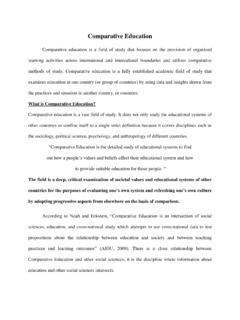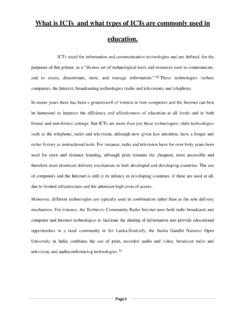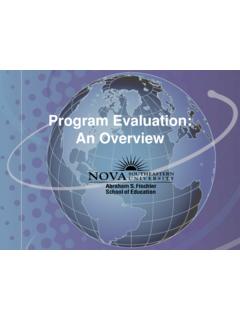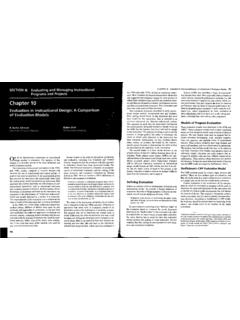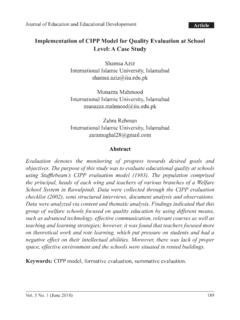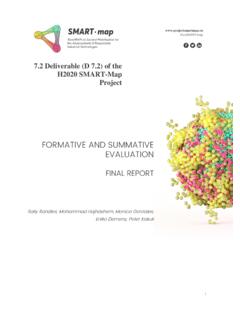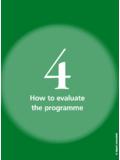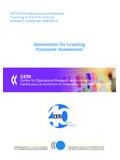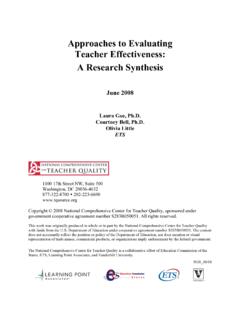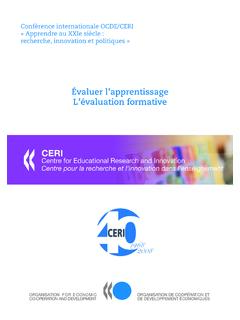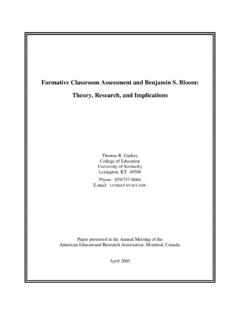Transcription of Educational measurement, assessment and evaluation
1 Educational measurement, assessment and evaluation 1. EDUCATIONALMEASUREMENT, assessment and evaluation A Study Guide Approach CREATED FOR BY: BOYET B. ALUAN 2. BASIC CONCEPTS AND PRINCIPLES A. TEST- B. MEASUREMENTS- C. assessment D. evaluation - 3. TEST--- most commonly used method of making measurements in education. It is also an instrument or systematic procedures for measuring sample of behavior by posing a set of questioning a uniform manner. Designed to measure any quality, ability, skill or knowledge. There is right or wrong answer. 4. MEASUREMENT-- assignment of numbers (quantity), uses variety of instrument: test, rating scale.
2 It is the process of obtaining numerical description of the degree of individual possesses. Quantifying of how much does learner learned. 5. assessment --- process by which evidence of student achievement is obtained and evaluated. Information is to objective it include testing, interpreting and placing information in context. It is the process of gathering and organizing data the basis for decision making ( evaluation ). Methods of measuring and evaluating the nature of the learner/(what he learned, how he learned). 6. evaluation --it is a process because it includes a series of steps (*establishing objective,*classifying objective, *defining objective, *selecting indicators, *and comparing data with objectives).
3 It is concerned with making judgments on the worth or value of a performance, answers the question how good, adequate, or desirable . It is also the process of obtaining, analyzing and interpreting information to determent the extent to which students achieve instructional objective. 7. HISTORYDEVELOPMENT OF INTELLIGENCE TESTGERMAN1. Ebbinghaus quantitative memory2. Kroeplin and Sommer association test3. William Stern mental quotient MQ= MA/CA4. Terman Intelligent quotient IQ= (MA/CA)*100 ENGLAND1. Galton questioning method and theory of eugenics statistical and experimental method2.
4 Pearson method of correlation (Pearson- product- moment coefficient of correlation) 3. Spearman rank correlation or Spearman Rho4. Spearman-brown formula reliability of full Split-half method half of the odd and even 8. FRANCE1. Esquirol mental disability and insanity2. Sequin board for mentally defectiveness using ten different sizes and shapes to be inserted in the Binet extensively used test for intelligence and whose thinking were influence. AMERICAN APPLIED PSYCHOLOGY1. James Mckeen Cattel father of mental Thorndike father of Educational Wechsler adult intelligent and deviation quotient4.
5 Raymond Cattel advance statistical technique, culture free or culture fair-intelligence Safran culture reduce intelligence test 9. DEVELOPMENT OF ACHIEVEMENT TEST1. Horace Man written and oral examination2. Fisher first objective test3. Rice comparative test4. Stone first standardize test in arithmetic5. Call objective test which is extensively used today6. Taylor evaluative test7. Gates basic reading test for grade 3-8 DEVELOPMNET OF CHARACTER AND PERSONALITY MEASUREMENT1. Fernald first to measure character by test2. Voelker some actual situations for testing character3. Symonds scientific study of personality4.
6 Rorschach personality test using ink blots 10. PURPOSE OF Educational TESTING AND MEASUREMENT Instructional ---test is given to assess students progress in a subject Curricular ---given when decision are to be made about school curricula. Selection ---test is given to determine students ability/suitability to enter school.(college entrance test)Placement --- test is given to group students (below average, geniuses, morons or homogeneous or heterogeneous)Personal --- assist individual to make wise decision for themselves (personality inventory test, aptitude test and its all standardize.) 11. assessment PRINCIPLES 1.
7 ADDRESS LEARNING TARGETS/CURRICULAR GOALS *cognitive*psychomotor*affective 2. PROVIDE EFFICIENT FEEDBACK ON INSTRUCTION *satisfactory (proceed to next) *unsatisfactory (reteach) 3. USE A VARIETY OF assessment PROCEDURES *knowledge * skills *attitudes 4. ENSURE THAT ASSESSMENTS ARE VALID, RELIABLE, FAIR AND USABLE, Valid- reflects PURPOSE of the test Reliability- yields CONSISTENCE on the results Fair- fee from BIASES Usability- PRACTICABILITY, coverage, convenience, economical 5. KEEP RECORD OF assessment *allow student to documents their performance (portfolio) 6. INTERPRET/COMMUNICATE THE RESULTS OF ASSESSMANT MEANINGFULLY *test with correct meaning, student can make correct decision, falling scores can motivate, passing can inspire 12.
8 CHARACTERISTICS OF MODERN assessment Objectives Reliable Multidimensional in structure Measures knowledge, skills and values Value-laden 13. FOUR KINDS OF STANDARD (ZAIS, 1976)ABSOLUTE MAXIMUM STANDARD (AMXS) -- attain by few students(95/100)ABSOLUTE MINIMUM STANDARD(ABMNS) -- attain by majority to 75/100 guarantee promotion)RELATIVE STANDARD (RS) --- competence compared to other MULTIPLE STANDARD --- level of performance or competencies, RANK. Combination of AmxS and AmnS and RSemploy to determine growth and pattern 14. INSTRUCTIONAL OBJECTIVES/LEARNINGOUTCOMES-- COMPOSED OF TWO ESSENTIALS outcomes -- ends results of instruction activities -- means to an ends Component: *behavioral- observables(include blooms taxonomy) and non- observables (know, appreciate, understand, value: to develop which are so general) Content specify the topic expected to learn.
9 * condition words such, given, using, *criterion level examples 75/100 acceptable level of performance 15. TAXONOMY OF INSTRUCTIONAL OBJECTIVES COGNITIVE DOMAIN (KCAPANSE) 1. evaluation 1. Recall of facts 2. Understanding 2. Synthesis 3. Use previously learned information in 3. Analysis new setting 4. Breaking down facts 4. Application of a whole 5. Combining or putting 5. Comprehension facts to gather to create new scheme 6. knowledge 6. Making judgments. 16. REVISED TAXONOMY OF Educational OBJECTIVE Knowledge (product) Process 1. Remembering retrieve 1. Factual knowledge memory 2. Understanding constructs 2.
10 Conceptual summarizing, explaining knowledge 3. Apply-- executions, implementing 3. Procedural knowledge 4. Analyze differentiate, integrate, attributing, 4. Meta-cognitive deconstructing, dissecting 5. Evaluate judgments, checking, testing, and critiquing 5. Comprehension 6. Create hypothesizing, designing, planning, 6. Knowledge constructing 17. AFFECTIVE DOMAIN1. Receiving ----willingness to receive (your teacher ask you to come in school early) then you accept2. Responding ----active participation, response in satisfaction (you comply to your teacher.)3. Valuing ----acceptance of value: preference and commitment (you believe the value of getting ahead of time) 4.


